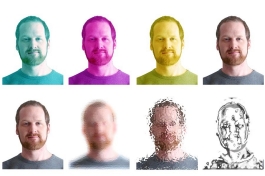Large-scale photographs by PhD student Scott McMaster will adorn the walls of the Department of Art Education until the end of October. We had the chance to catch up with this artist-educator to ask him about his work and what inspires him.
What are you working on right now?
At the moment I’m working on my thesis writing, writing a short book chapter on the role of visual culture’s global influence via the internet (the same research covered in my thesis study) and helping to organize a conference in San Francisco for the International Visual Literacy Association. I also always try to find time to do some photography.
What has your attention? What are new trends and/or new directions in your area of research or creation?
In short, everything visual. There is distinctive trend in awareness of and engagement with visuality in many forms and across disciplines. Researchers are now taking up the cause of visual research methods in increasing numbers and the importance of imagery and its influence on culture and society has become more prominent in academia. This trend is of course a response the exponential expansion of visuals used for and created with technology that encompass our daily lives; we are now easily exposed to more imagery per year than previous generations were in their whole lifetimes.
This saturation is obviously exemplified in mediums such as photography as critics and scholars question a ‘post-photographic condition’, a ubiquity of image capturing technologies accompanied by a glut of images from everyone and on every subject imaginable. However I am not yet sold on this concept or condition and think it resembles previous trends after the turn of the last century when film photography entered mass production and consumer culture. Another interesting concept that is often encountered in photography is the idea of truth; this is a precarious and infinitely revealing idea as we deal with the aforementioned ubiquity of the personal photo and its constant circulation on social media. What truths, if any, does the contemporary photo hold? How do we discern between the fake, the unintentional and the deliberately misleading images that cross our screens in the hundreds and thousands each day? What impact does our belief in the veracity of the photograph have on our production and consumption of them and the embodied messages contained within?

